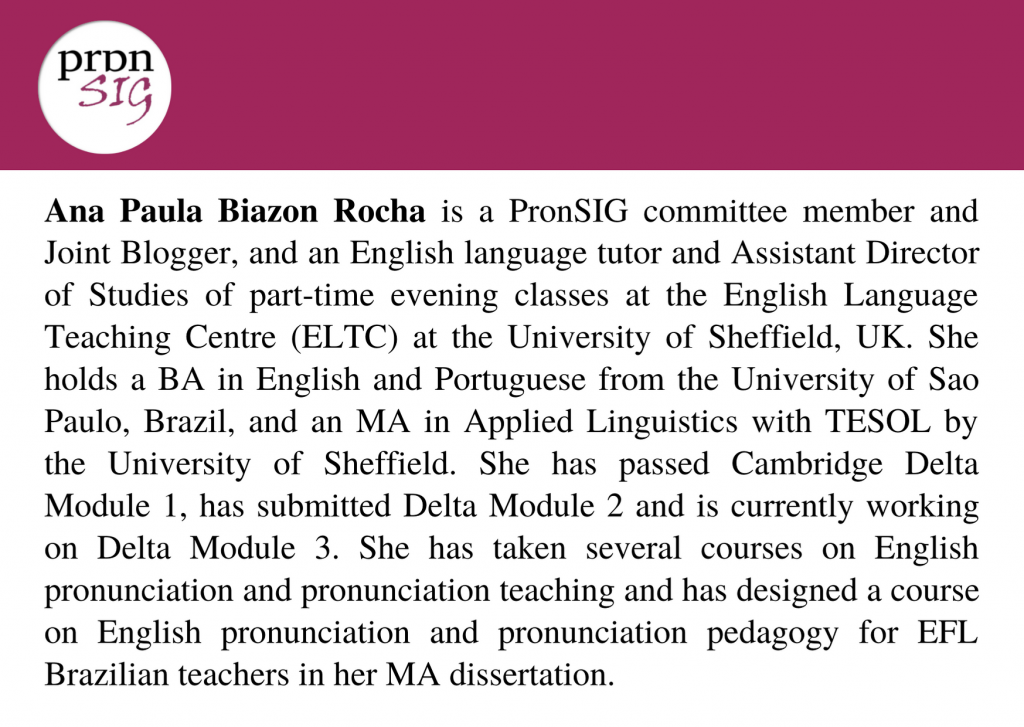by Ana Paula Biazon Rocha
When teaching pronunciation, one of the many questions that may arise is how and when to correct our learners’ pronunciation mistakes. We certainly don’t want to overwhelm them with loads of corrections and theoretical explanations, but at the same time, we should not simply overlook their mistakes. Thus, let’s reflect and find out how to correct pronunciation mistakes.
First, it’s important to bear in mind that the correction of learners’ mistakes should not be our choice as teachers: some teachers do, others don’t, but it’s an integral part of our teaching to help students in their language learning process. In other words, ‘learners should receive helpful feedback which will allow them to improve the quality of their language use’ (Nation & Macalister, 2010, p. 65). In terms of pronunciation, such feedback should be ‘systematic, explicit and targeted’ (Brinton, 2014, p. 235). That is, it should a) always happen in class, not only during pronunciation activities, b) be clear to students, and c) relate to an area of pronunciation, for example, articulation of sounds, word/sentence stress, intonation, connected speech, etc.
Second, it’s also necessary to reflect on what we mean by a pronunciation mistake. As the focus of pronunciation teaching is intelligibility, that is, understand and be understood in real-life instances of language use (Derwing & Munro, 2015), a pronunciation mistake refers to ‘unintelligible or odd sounding pronunciation’, that is, when it’s not possible to understand what the student is trying to say (Lane, 2010, p. 15). It’s definitely not about our students’ accent or the attempt to imitate standard English pronunciation accents (Hancock, 2020).
Thus, focussing on the importance of corrective feedback to help students sound intelligible, here are some suggestions:
1. Recast: The learner makes a mistake and the teacher recasts it into the correct form, hoping the learner will notice and copy it (Watkins, 2005):
Student: It’s a comforTAble couch.
Teacher: A COMfortable couch.
Student: Yeah, a COMfortable couch.
Teacher: Yes, good.
2. Cues: The student makes a mistake and the teacher uses a clue by saying ‘Pronunciation’ or ‘Be clearer’, etc., so the student understands that they have made a pronunciation mistake and should correct it. The clue should be previously negotiated and made clear to learners (Lane, 2010; Watkins, 2005).
Student: I work as a maNAger.
Teacher: Pronunciation.
Student: MAnager?
Teacher: Yes, good.
Student: MAnager.
3. Silence: The student makes a mistake and the teacher doesn’t say anything but writes the correct form on the board, on a piece of paper, in the chat box, etc., so the student can notice it:
Student: I was about to live.
Teacher (types in the chat box): leave
Student: Leave?
Teacher: Yes, good.
Student: I was about to leave.
An interesting variation of this technique is to write what you have understood and show it to the student, so they can visualise they said something unintelligible. Then, as they try to change it, you should keep on writing what you have understood until the student pronounces the accurate form (Hancock, 2020).
4. Gestures: the learner makes a mistake and the teacher uses gestures to indicate what is wrong (Watkins, 2005, p. 91):
- ‘Student uses an inappropriate intonation pattern
- Teacher repeats the utterance, while indicating the direction of the voice by waving their arm’
For more on how to teach pronunciation with your hands, check our first blog post here.
5. ‘de DA de de’: the student misplaces stress and the teacher uses a rhythmic stress pattern to enhance the student’s perception (Watkins, 2005, p. 91) – the more creative you are, the more helpful and fun it will be for your learners:
Student: He’s a PHOtographer.
Teacher: de DA de de (or na NA na na, la La la la, etc.)
Student: PhoTOgrapher?
Teacher: Yes, good.
6. Phonemic chart: the learner has problems with the articulation of a vowel sound, for example, and the teacher points to the correct vowel sound on the chart (Watkins, 2005). Even if students are not familiar with the phonemic chart, I usually point to it and stress the difference between the sound they are making and the accurate one. It’s not necessary to explain all the sounds in the phonemic chart, remember: feedback should be focussed!
Student: I didn’t get that because I arrived l/e/te.
Teacher (pointing to the phonemic chart): l/e/te or l/eɪ/te? (repeat two or three times)
Student: L/eɪ/te?
Teacher: Yes, good.
7. Peer correction: in pair or group work, ask students to pay attention and correct each other instead of having you as the centre of correction everytime they make mistakes (Brinton, 2014), provided they feel confident in doing that and respect each other. For example, they can look up the correct pronunciation in the (online) dictionary, and then they can teach the accurate pronunciation to the class.
Finally, avoid correcting learners during fluency activities because they tend to lose their train of thought and focus on the mistake rather than on their speaking. Take notes instead and then work on them during the feedback stage (Watkins, 2015). Concentrate on learners’ perception of the mistakes instead of having them repeat after you meaninglessly (Underhill, 2005). For more on how to enhance ‘listen and repeat’ practices in class, check our second blog post here.
Last but not least, be careful with the concept of ‘right’ or ‘wrong’ pronunciation. Ensure learners understand that there might be variety in the way sounds are pronounced and that they should aim at sounding intelligible, not ‘correct’ or ‘perfect’ (Hancock, 2020). Their mistakes are supposed to be learning opportunities (Underhill, 2005), not a source of pressure. We already have too much pressure in life, we don’t need more!
Don’t forget to follow PronSIG on social media and leave your comments below.
References
Brinton, D. M. (2014). Epilogue to the Myths: Best Practice for Teachers. In Grant, L. Pronunciation Myths. Applying Second Language Research to Classroom Teaching. Ann Harbor: University of Michigan Press. pp. 225-242.
Derwing, T., & Munro, M. (2015). Pronunciation Fundamentals: Evidence-based Perspectives for L2 Teaching and Research. Amsterdam: John Benjamins.
Hancock, M. (2020). 50 Tips for Teaching Pronunciation. Cambridge: Cambridge University Press.
Lane, L. (2010). Tips for Teaching Pronunciation: A Practical Approach. White Plains, NY: Pearson Longman.
Nation, J. & Macalister, I. S. P. (2010). Language Curriculum Design. New York and London: Routledge.
Underhill, A. (2005). Sound Foundations (Second Edition). Macmillan Books for Teachers. London: Macmillan.
Watkins, P. (2005). Learning to Teach English. A Practical Introduction for New Teachers. Delta Publishing.


